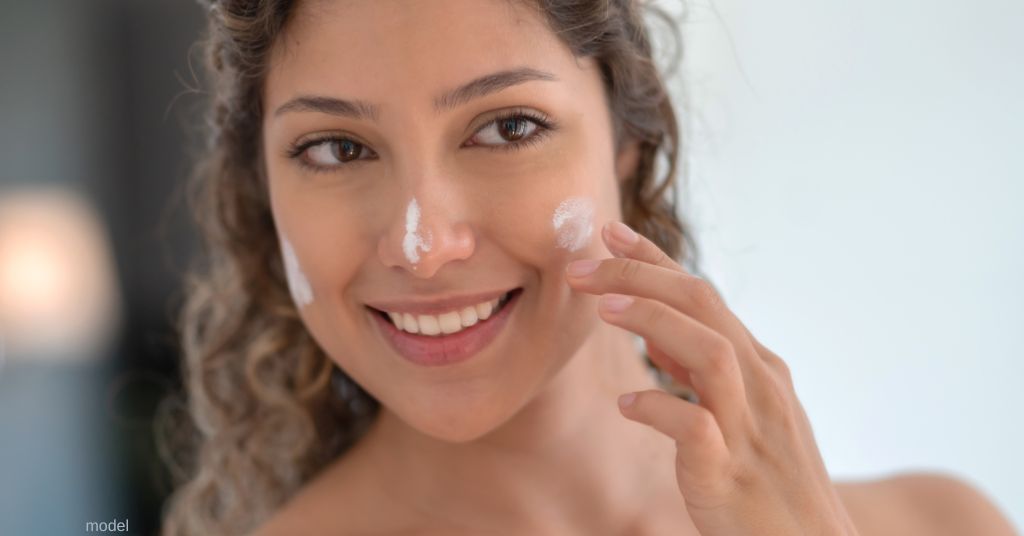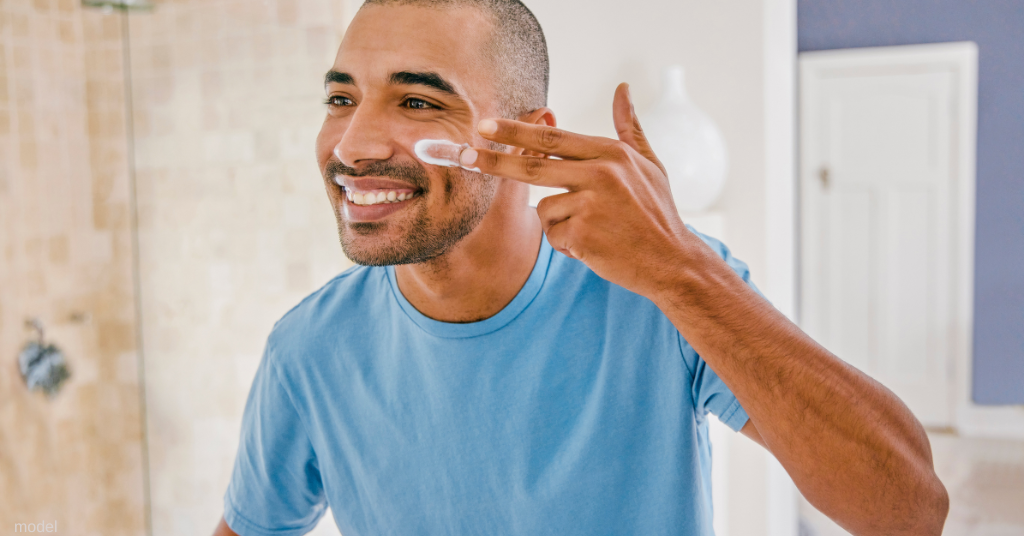Protecting your skin from the Texas summer sun is essential for maintaining its health and youthful appearance. Being active outdoors during the summer is fun, and many people consider tanned skin attractive. But over time, the skin develops a weathered, wrinkled look that leads people to seek sun damage treatment at our Houston dermatology clinics.
Why Is Sun Exposure Bad for the Skin?
The consequences of excessive sun exposure go beyond cosmetic issues. Skin cancer of various types is the most commonly diagnosed cancer in the United States.
The immediate danger of too much sun is sunburn. If you looked at sunburned skin under a strong microscope, you would see that the cells and blood vessels have been damaged. With repeated sun damage, the skin starts to look dry, wrinkled, discolored, and leathery. Although the skin appears to be thicker, it actually has been weakened and, as a result, it will bruise more easily.
How Does the Sun Damage Your Skin?
Many people know that our skin absorbs ultraviolet (UV) radiation emitted by the sun. Fewer people understand that the sun emits two types of UV radiation that affect our skin—UVA and UVB. (A third type, UVC, reacts with the ozone and does not reach the ground.)
UVB rays cause sunburned skin. They also play the greatest role in causing skin cancers, including the deadly black mole form of skin cancer (malignant melanoma). They’re also linked to basal and squamous cell skin cancer, which are much more common.
UVA rays also play a role in skin cancer formation. In addition, UVA rays penetrate deeper into the skin and play a more significant role in premature skin aging, including wrinkles and lines such as crow’s feet and discoloration. There are approximately 500 times more UVA rays in sunlight than UVB rays. That means it’s important to protect the skin from both UVA and UVB rays. Traditional chemical sunscreen products have been more successful at blocking UVB rays than UVA rays.
What About the Health Benefits of Sun Exposure?
Vitamin D is essential for our overall health, and the sun is an excellent source. But how much do we need, and how is that balanced with the health risks posed by getting too much sun? Because many foods are fortified with vitamin D, sun exposure is not as important for maintaining the body’s supply of it as it once was. Still, it’s healthier to lead an active lifestyle outside than to be sitting inside watching television. It’s not clear how much vitamin D the body needs and how to ensure you get it without too much exposure to sunlight.
There’s no question, however, that protecting yourself from the sun’s damaging effects while you’re enjoying yourself outdoors is essential—especially during the longer days of summer.
What’s the Best Way to Protect Your Skin From the Sun?
You can take various steps to avoid too much sun exposure, and these interventions are very effective. The two primary forms of shielding your skin from the sun’s harmful UV rays are wearing clothes and hats that protect the skin and applying sunscreen.
What Type of Sunscreen Is Best?
A few decades ago, sunscreen was called suntan lotion, and it provided minimal protection from the sun. Today, several products effectively prevent the sun’s rays from damaging the skin.
- Find a sunscreen that’s designated as “broad spectrum.” Broad-spectrum sunscreen blocks both UVA and UVB rays.
- Check the sun protection factor number, or SPF, on the sunscreen.
A sunscreen’s SPF number indicates how many minutes it will take someone with “average” skin to get a sunburn when using that specific sunscreen. An SPF of 15, for example, means your skin is protected for 15 minutes before sun damage begins occurring. The most effective sunscreens have an SPF of 30 or higher.
When choosing a sunscreen or SPF, consider how it fits into your lifestyle. Makeup with sunscreen, tinted sunscreens, or sheer (clear) sunscreens are some of the possible options. Consider what works best for you before buying as the bottom line is: if it doesn’t get put on, it won’t help!
How To Use Sunscreen
Have you ever applied sunscreen just before spending several hours outside and then returned home and wondered why you have a sunburn? Remember the significance of the SPF number? Applying sunscreen once only protects your skin for a certain amount of time. When used properly, sunscreen is very effective when following these guidelines:
- Apply sunscreen at least 20 to 30 minutes before you go outdoors if you expect to be outside for 30 minutes or more. This advice applies year-round as the sun can still cause damage on cloudy, overcast, or even wintry days!
- Reapply sunscreen every 2 hours while you are outdoors, even if the product is labeled “all day.” If you get wet or sweat heavily, reapply more frequently.
- Don’t overlook applying sunscreen to your ears, lips, face, back of the neck, and back of your hands (and the top of your feet, if you’re wearing sandals or flip flops).
- Don’t skimp; apply a generous layer. Smooth it on rather than rubbing it in. A rule of thumb is that 45 ml (a shot glass) of sunscreen is needed to cover all exposed skin to attain the stated level of protection. Your face alone should require about a nickel-sized amount of sunscreen.
- If you intend to wear makeup, apply sunscreen first and then your makeup. If you wait to apply sunscreen until you hit the beach, you may already be perspiring, and moisture makes sunscreen less effective.
If you have children, including infants older than 6 months, apply sunscreen to them every time you reapply it to your own skin.
Other Tips for Sun Protection
Besides wearing protective clothing, wide-brimmed hats, and using sunscreen, what else can you do to avoid too much exposure to the sun’s harmful ways? Here is a list:
- If possible, avoid being outside between 11 a.m. and 4 p.m., when the sun is especially intense.
- Find some shade if you are outside during those peak hours.
- Wear sunglasses that block UV rays.
- Avoid recreational sunbathing and don’t use tanning beds.
- Always have a hat in your car.
Treatment for Sun Damage
It’s great to protect skin from sun damage, but what about the signs of excess sun exposure that you already have? Can you reverse sun damage?
Aesthetically speaking, the answer is yes. DermSurgery Associates offers a wide range of restorative skin treatments that can address wrinkles and discoloration for a healthy, youthful glow. We can strengthen the skin and create a more even tone and texture, but we can’t “cure” the deeper, functional damage.
With this distinction in mind, we will walk you through how to repair sun-damaged skin, including how to get rid of visible sun damage on your face using nonsurgical cosmetic procedures.
Chemical Peels
To answer the question, “How do chemical peels help with sun damage?” we first need to look at what a chemical peel does.
A chemical peel exfoliates the outer, damaged layer of skin to promote new cell growth and reveal the healthier tissue beneath. Each peel uses an acid-based solution to even out skin tone, minimize visible aging and photodamage, and treat surface irregularities (acne scars, wrinkles).
Microneedling
Microneedling is often associated with skin tightening, increased collagen production, and improvements in the appearance of scars. How does microneedling help sun damage? Its 14 medical-grade needles break up the melanin that causes discoloration, for more evenly pigmented skin.
Our SkinPen® microneedling treatment uses micro-punctures to trigger new collagen and elastin production. By remodeling the skin, microneedling not only fades sun damage and age spots but also visibly improves the texture, strength, and quality of the skin.
Laser Skin Resurfacing
DermSurgery offers several laser treatments to rejuvenate the skin, including:
What is the best laser treatment for sun-damaged skin? It depends on your cosmetic concerns. Fraxel laser treatments stimulate collagen production for healthier, younger-looking, and more resilient skin. It targets aging, damaged skin, and is safe for use on the face (Fraxel Dual) and body (Fraxel re:pair).
QSRL and Nd:Yag laser treatments are ideal for precise spot treatments of uneven pigmentation. PicoSure also breaks up hyperpigmentation across the face and body (arms, legs, hands, chest, and neck) and can reduce wrinkles as well.
Lastly, Clear + Brilliant restores radiance by improving the skin’s tone and texture and minimizing visible signs of aging and photodamage.
Light-Based Treatments
The last category of nonsurgical skin-repairing procedures is our light therapy treatments:
Intense Pulsed Light treatments (also known as a photofacial) use light energy to improve hyperpigmentation, promote collagen production, and support a balanced, even complexion across the face and body.
Cutera LimeLight is one such form of IPL treatment. The LimeLight Facial is a gentle procedure that can correct excess redness, brown spots, and other signs of photodamage on the face, neck, and chest.
Photodynamic Therapy is an extremely powerful treatment that not only treats active acne and sun damage but also kills pre-cancerous skin cells.
The treatment involves a photosensitizing agent that is absorbed into the skin and then activated by high-intensity light. The resulting reaction preferentially destroys the damaged skin without causing harm to the surrounding area.
Remember that while cosmetic treatments can go a long way in correcting an uneven skin tone and restoring a vibrant, youthful glow, the best way to heal your skin from sun damage is to be proactive in protecting it.
We hope you enjoy the sunshine safely and encourage you to schedule annual mole checks with your dermatologist. Remember: skin cancer is prevalent, but it is preventable with consistent good habits.
Please request a consultation or call us at (713) 791-9966 to take the next steps toward healthier skin from the inside out.




Leave a Reply